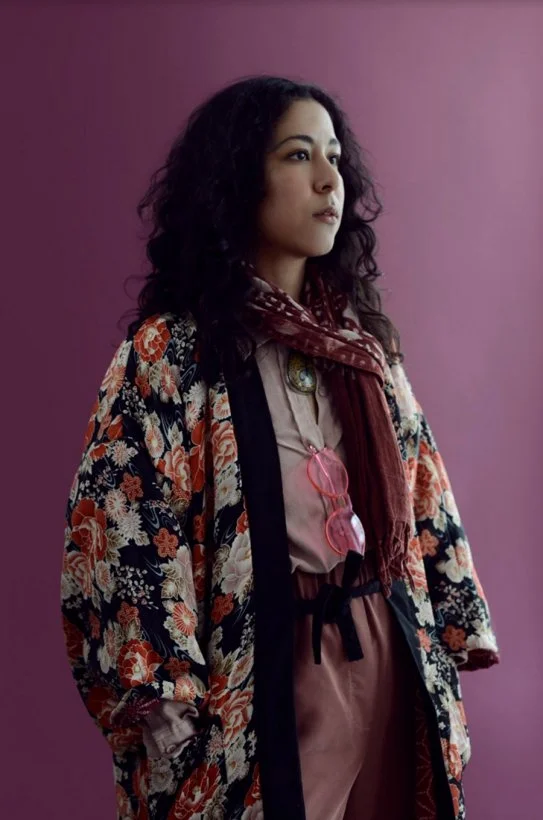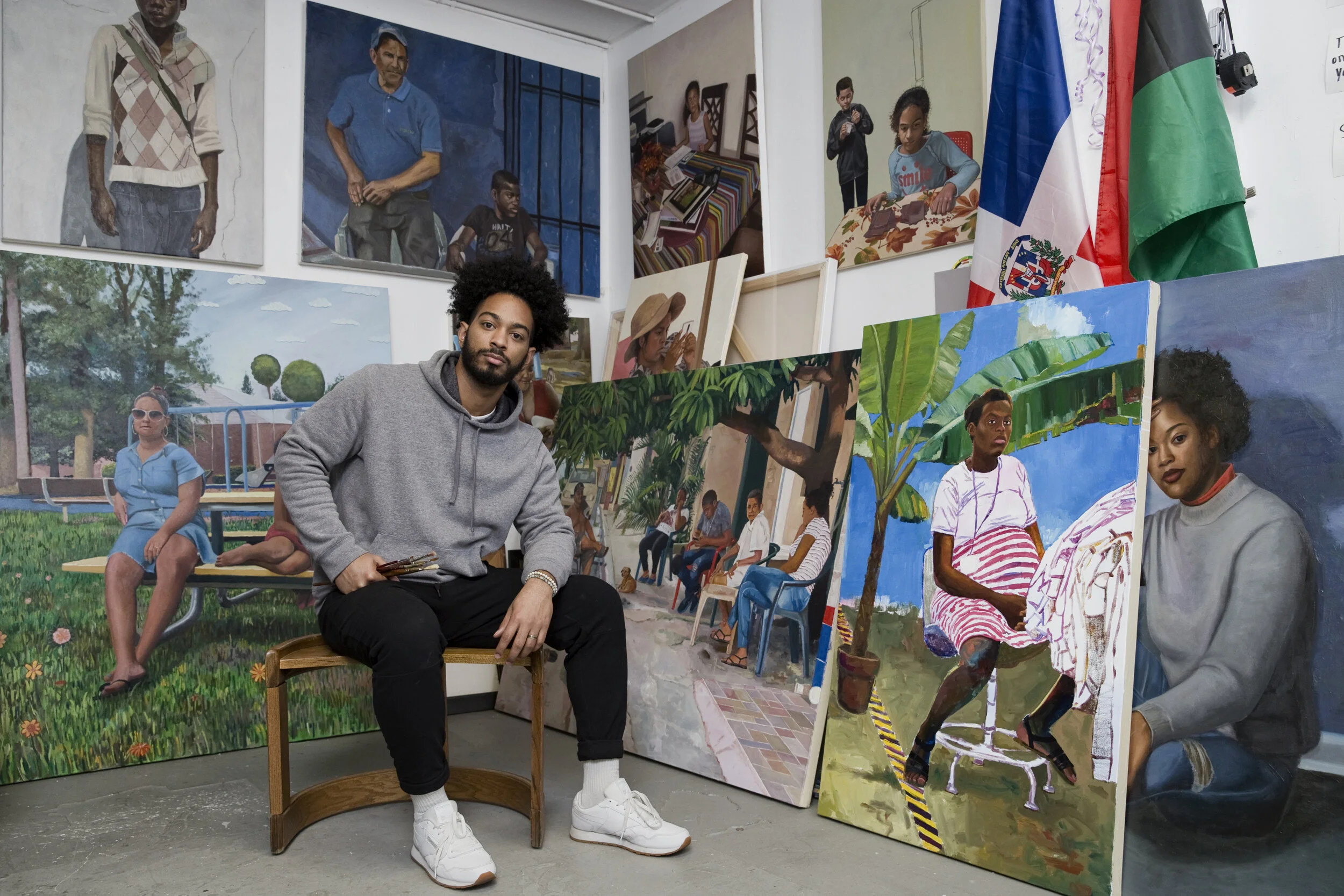In Conversation with Aya Rodriguez-Izumi: The Beauty Behind Everyday Practices as Rituals
Photo by Nir Arieli.
Aya Rodriguez-Izumi conjures special spaces and experiences. At her exhibits, walking through her installations feel like mini soul-cleansing sessions being held at these mobile sanctuaries that she creates. I talk with the New York-based, Latinx artist of Cuban/Puerto Rican/Okinawan descent on her emotional installations and what's next for 2018.
Offering, 2016. Courtesy of the artist.
Gallery Gurls: You've created several tinsel-based installations that emote feelings of personal sanctuary. I experienced this when I walked through 'Offering' (2016) at the MAMI exhibit. Can you talk more about creating these spaces within your work?
Aya Rodriguez-Izumi: The installation “Offering” also served as the stage for an accompanying performance, called “Initiation”. In it, viewers are guided into the piece and asked to share an experience of loss. In exchange they receive entry into the small community of those who have gone through this invented rite. This interaction is represented through the transfer of a bracelet via clasped hands from guide/performer to initiate/viewer. For such a intimate interaction to even be possible, the piece needed to be a space that inspired safety as well as freedom. Inherently, the materials create the sanctuary like quality.
I was drawn to tinsel as a material because of its expression of quotidian celebration, but what it does physically is also essential to the piece. It has the ability to give form to the invisible—elements we can’t see like wind, breath, sound vibrations, echoes of actions. My installations become objects that respond to their environment and those who interact. They give the illusion of a solid form but are completely penetrable. Once a viewer decides to enter, they become enveloped but are also manipulating and changing the piece. This interaction becomes very reciprocal and is also a disorienting one. But everyone really has their own experience when it comes to these immersive pieces. I’m always interested in observing how people interact with the work and how they seem to be affected. Its has really become a practice in guiding people through an experience.
Alt(e)ar, 2017. Courtesy of the artist.
On your website you talk about the act of rituals, how everyday practices can be ritualistic, you also tie in your Cuban/Puerto Rican/Okinawan background. How does it all come together?
Rituals and ceremonies have been a part of my life since I can remember. My father’s reached initiation into priesthood in the Yoruba system of Candomblé, my mother practices a spiritual system thats rooted in Okinawa, Japan. These customs were handed down to me with an emphasis on mindfulness and intention. When we can carry such ideas into everyday actions, personal rituals form and something as simple as making coffee, getting a haircut or walking down the street can take on a ceremonial quality, complete with its own private set of actions and specific regalia. I think where religious actions and rituals of the everyday overlap is how they both can functions. they are both systems that we’ve created to understand the world and occurrences around us. To me, rituals in various forms are how we come to terms with being human.
"When we can carry such ideas into everyday actions, personal rituals form and something as simple as making coffee, getting a haircut or walking down the street can take on a ceremonial quality, complete with its own private set of actions and specific regalia."
Documentation of performance “No. 1 Pretty”, 2018. Courtesy of the artist.
I read how No. 1 Pretty was inspired by memories from your childhood in New York and Japan and your experience as a nail artist. Can you expand?
One of my first jobs out of undergrad was working as a receptionist at a small Japanese nail salon on the Upper East Side. At the time, it was one of the only places in New York doing gel or 3D nail art which I was so obsessed with. I had been a customer there for a while, and without really knowing it my visits had become a monthly self-care ritual I held. When I graduated and needed a job, my nail lady hooked it up because I was bilingual and there was often a language barrier between nailists and customers that they thought I could help with. I learned how to do nails there and started doing manicures out of my apartment, all through word of mouth and mostly for friends and friends-of-friends in my neighborhood of East Harlem. Nails for me are a lot about the interactions that happen during the process.
No 1 Pretty was a piece that I’d been mulling over for a few years and started with an exploration of the actions and interactions that take place during a manicure process while accenting those that mirror ritualistic expressions. I wanted this piece to act as a ritual that could be used to access and analyze something subconscious, in this case I was interested in dreams. I was, and still am, in the process of analyzing the symbols in my own dreams, at that time many of which were pointing to my own history and family. No 1 Pretty manifested as an installation and performance that took a familiar set of actions and turn those into a choreography that guided the viewer through steps to reflect on their own dreams and was an abstract roadmap to lucid dreaming. The multiple settings were all references from my own history and entries in my personal dream journal, so the piece in its entirety became the viewer analyzing and revealing their own dream while walking through mine.
"No 1 Pretty was a piece that I’d been mulling over for a few years and started with an exploration of the actions and interactions that take place during a manicure process while accenting those that mirror ritualistic expressions."
Documentation of performance “Initiation”, 2016. Courtesy of the artist.
In your own words what does intersectional feminism mean to you?
To me, intersectional feminism represents a movement and expression of a collective community. I understand where my works interacts and exists with such concepts, however at the same time I wouldn’t necessary describe this work entirely as such.
What is next for you in 2018?
I’m part of the 2018 group of fellows at A.I.R. Gallery and will have my solo show opening there on June 28th, and this summer I’ll be in Minnesota at Franconia Sculpture Park creating an outdoor piece.
You can follow Aya Rodriguez-Izumi on Instagram: @_iamaya_










